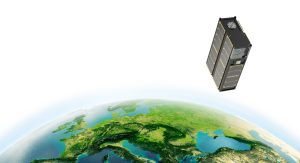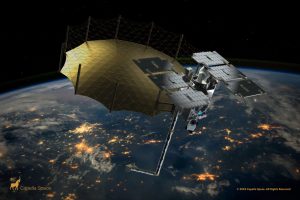It marks the initial stage of Kuva’s constellation, which aims to provide daily observation by 2027 and gapless subdaily global monitoring with 100 satellites by 2030.
The microsatellite – launched on SpaceX’s Falcon 9 from the Vandenberg Space Force Base last week – is equipped with a patented hyperspectral camera. It enables acquisition modes that allow Kuva to distinguish the molecular composition of nearly any material on Earth, and its condition, through distinct spectral signatures.
The company’s AI-powered analytics platform combines hyperspectral data with third-party data, “to create decision-ready insights within 15 minutes”. For example, the company is planning to monitor and identify crop species, growth stages, biomass health, harvest times, algae blooms, water quality, and illegal vessel activities.
“Hyperfield-1 launch is a critical milestone for the Kuva Space’s mission,” said the CEO of Kuva Space, Jarkko Antila. “The immense learning the team garnered in the past two years, both on satellite and AI-powered processing pipeline and customer needs, is giving us a firm foundation to build world-class services.”
“When the Hyperfield-1 satellite commissioning period ends, we will open early access to a selected group of customers to test, validate, and co-create domain-specific services. Our early access program will help customers learn firsthand how novel hyperspectral insights can make their business more climate resilient,” he continues.
Kuva Space co-developed the camera technology in Hyperfield-1 with VTT Technical Research Centre of Finland.
A second satellite, Hyperfield-1B, will be deployed in Q1 2025 as part of the ESA InCubed programme, said the company. Later in 2025, the second generation of Hyperfields will be launched with enhanced specifications, it adds.
Hyperspectral
In May it won a €1.8 million contract to be part of the European Space Agency’s (ESA) Civil Security from Space (CSS) programme.
This is to provide advanced hyperspectral situational awareness information, for monitoring and helping to manage civil security and crisis events.
As part of a three-year R&D programme, the company will develop and test on-board hyperspectral data processing, Sat-to-Sat, and Sat-to-IoT mobile communications. This will be demonstrated with a field study with the Finnish authorities, to improve border surveillance by detecting illegal activities along the Baltic Sea area between Finland, Estonia, and Sweden.
Spectral signatures
The Finnish company can distinguish the molecular composition of nearly any material on Earth with its microsatellites, which use the embedded hyperspectral camera to detect distinct spectral signatures. It means the company can monitor things like crop types, plant health and biomass, carbon sequestration, soil conditions and seaweed growth.
Kuva Space’s commercial model will be provide a near real-time monitoring tool as a subscription service.
See also: Kuva Space series A to fund AI analytics platform and hyperspectral camera
 Electronics Weekly Electronics Design & Components Tech News
Electronics Weekly Electronics Design & Components Tech News




